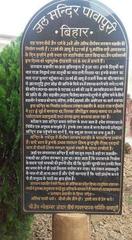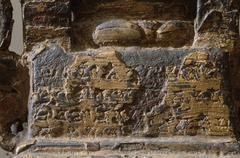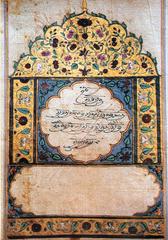Visiting the Tomb of Malik Ibrahim Bayu, Bihar, India: Tickets, Hours, and Travel Tips
Date: 14/06/2025
Introduction
The Tomb of Malik Ibrahim Bayu, perched atop Bari Pahari (Peer Pahari) in Bihar Sharif, Nalanda district, is a monument of immense historical, architectural, and cultural significance. Dedicated to Malik Ibrahim Bayu—a 16th-century administrator and revered Sufi saint—this site stands as a symbol of Bihar’s syncretic heritage, blending Indo-Islamic architectural traditions with a vibrant spiritual legacy. This comprehensive guide provides historical background, practical visiting information, conservation insights, and travel tips to help you plan an enriching and respectful visit (Trans India Travels, New Age Islam, Bihar Tourism).
Historical Overview
Malik Ibrahim Bayu: Life and Legacy
Malik Ibrahim Bayu (also known as Malik Ibrahim Vaya) was a distinguished figure in late medieval Bihar. As a prominent administrator during the consolidation of Muslim rule in the region, he played a pivotal role in promoting political stability, religious tolerance, and economic growth. Under his leadership, Bihar Sharif became a center for trade, scholarship, and Sufi spirituality (Trans India Travels).
Context: 16th-Century Bihar Sharif
Bihar Sharif, formerly a Pala dynasty capital, flourished as a significant Islamic hub under subsequent rulers. Malik Ibrahim Bayu’s era witnessed the construction of mosques, tombs, and other public works that embodied the region’s syncretic culture. Its fertile location along the Panchanan River contributed to its prosperity (Trans India Travels).
The Tomb of Malik Ibrahim Bayu: Architecture and Setting
Location and Surroundings
The tomb sits atop Peer Pahari, about one mile west of Bihar Sharif, offering panoramic views of the surrounding landscape. This elevated position not only enhances its spiritual prominence but also makes the site visible from afar, enveloped by tranquility (New Age Islam).
Architectural Layout and Features
- Date of Construction: Circa 1351–1353 CE (753 Hijri)
- Area: 708 sq. ft. (inner sanctum: 316 sq. ft.)
- Boundary Wall: 48 feet long, with 8.3-feet-thick walls
- Materials: Thin medieval bricks and lime mortar, ensuring durability and natural cooling
- Dome and Roof: Modest, subtly curved roof influenced by early Persian and Central Asian styles, in line with Sufi aesthetic values
- Entrances and Arches: Main entrance with a pointed arch, smaller niches possibly for lamps or inscriptions
- Interior: Simple, with geometric patterns and calligraphic inscriptions, promoting an atmosphere of spiritual focus
- Courtyard: Ample space for gatherings, particularly during the annual Urs festival (New Age Islam, Wikipedia)
Artistic and Cultural Significance
The tomb is a testament to the Ganga-Jamuni tehzeeb—Bihar’s unique blend of Hindu and Muslim traditions. Its Indo-Islamic design, use of calligraphy, and harmonious integration with the landscape reflect both spiritual humility and architectural finesse (World Architecture).
Religious and Cultural Importance
Syncretism and Interfaith Harmony
The tomb remains a beacon of religious syncretism. Sufi traditions associated with Malik Ibrahim Bayu emphasize universal love and dialogue, attracting pilgrims and visitors from various faiths. Local rituals during the Urs festival often see participation from both Muslim and Hindu communities, reinforcing the monument’s role in fostering communal harmony (Religious Syncretism in India).
Pilgrimage and Rituals
The annual Urs festival is the highlight of the site’s ritual calendar, marking Malik Ibrahim Bayu’s death anniversary with prayers, qawwali performances, and communal meals (langar). Devotees tie threads, offer flowers, and seek blessings, practices deeply rooted in Sufi and local traditions (Urs Festival).
Educational and Social Outreach
Inspired by the Sufi ethos, the tomb has influenced the establishment of madrasas, charitable trusts, and community initiatives that extend support to people of all backgrounds (Role of Sufi Shrines in Social Welfare).
Visiting the Tomb: Practical Information
Visiting Hours
- Standard Hours: 8:00 AM – 6:00 PM (some sources mention 9:00 AM – 6:00 PM; best to confirm locally)
- Urs Festival: Hours may be extended during special events
Entry Fee
- Admission: Free for all visitors
Accessibility
- Approach: Short but uphill walk; uneven paths may present challenges for those with mobility issues. Wheelchair access is available at the main entrance in some areas, but assistance may be needed.
- Travel: Baragaon village (site of the tomb) is accessible via Bihar Sharif, which is well-connected to Patna (120 km) by rail and road. Local taxis and auto-rickshaws are available for the final stretch (Sea Water Sports, Bihar Sharif Online).
Best Time to Visit
- Ideal Months: October to March (pleasant weather, Urs festival)
- Nearby Attractions: Bukhari Mosque, tomb of Makhdum Shah Sharif-ud-din, Nalanda ruins, and other Sufi shrines
Facilities and Amenities
- Essentials: Limited amenities—carry water, snacks, sun protection, and wear comfortable shoes
- Safety: Area generally safe; standard precautions advised
- Photography: Permitted, but seek consent before photographing people or ceremonies
Code of Conduct
- Dress modestly, covering arms and legs; head coverings recommended for both men and women inside the mausoleum
- Remove shoes before entering the tomb
- Maintain silence and reverence during prayers
- Avoid smoking, alcohol, and disruptive behavior
Guided Tours
- Local caretakers and guides are often available to share historical anecdotes and cultural insights, enhancing your experience
Conservation and Preservation
Ongoing Efforts
The tomb is protected under the Archaeological Survey of India. Conservation work includes:
- Use of traditional materials and techniques for restoration
- Community-led cleaning drives, especially before large gatherings
- Managing visitor flow to minimize wear and tear (Sea Water Sports, Bihar Sharif Online)
Government and NGO Support
The Bihar Department of Art, Culture, and Youth works with local NGOs to document, restore, and promote the site. These collaborations help raise awareness and secure funding for ongoing preservation.
Visitor Experience
- Scenic Views: Hilltop location offers panoramic vistas of Bihar Sharif and the plains
- Spiritual Ambience: The peaceful setting and Sufi rituals provide a contemplative experience
- Cultural Engagement: Interact with local caretakers and participate in communal activities for a deeper understanding of the site’s significance (Amlan the Tramp)
Frequently Asked Questions (FAQ)
Q: What are the visiting hours?
A: Generally 8:00 AM to 6:00 PM daily (confirm locally).
Q: Is there an entry fee?
A: No, entry is free.
Q: Is the site accessible for differently-abled visitors?
A: Main entrance is wheelchair accessible; some areas may be uneven.
Q: How can I reach the tomb from Patna?
A: Patna is 120 km away. Take a train or bus to Bihar Sharif, then a local taxi or auto-rickshaw to Baragaon village.
Q: When is the annual Urs festival?
A: Dates vary according to the Islamic lunar calendar; check local sources for updates.
Q: Are guided tours available?
A: Local guides and caretakers can provide information; no formal tours.
Visuals and Media Suggestions
- Include high-resolution images of the tomb’s façade, dome, carvings, and the annual Urs festival (alt text: “Tomb of Malik Ibrahim Bayu red sandstone façade,” “Urs festival at Malik Ibrahim Bayu tomb”).
- Provide an interactive map highlighting Baragaon village and key attractions.
- Offer links to virtual tours if available.
Summary and Visitor Recommendations
The Tomb of Malik Ibrahim Bayu is a vital cultural and spiritual monument, reflecting centuries of Indo-Islamic artistry, religious syncretism, and communal harmony. Free to visit and set in a serene landscape, it offers a unique window into Bihar’s medieval history and Sufi heritage. For a comprehensive experience, visit during the Urs festival, explore nearby historical sites, and engage with local guides. Respect the site’s customs, plan your trip during the cooler months, and support ongoing conservation efforts through responsible tourism.
For more details, updates, and curated travel guides, consult Sea Water Sports, Bihar Sharif Online, and download the Audiala app.
Sources and Further Reading
- Trans India Travels
- New Age Islam
- Britannica: Sufism in India
- Religious Syncretism in India
- Urs Festival (LiveMint)
- Oxford Bibliographies: Sufi Philosophy
- JSTOR: Role of Sufi Shrines in Social Welfare
- Sea Water Sports
- Bihar Sharif Online
- Bihar Tourism Official Site
- Wikipedia: Malik Ibrahim Bayu
- Amlan the Tramp
- World Architecture


